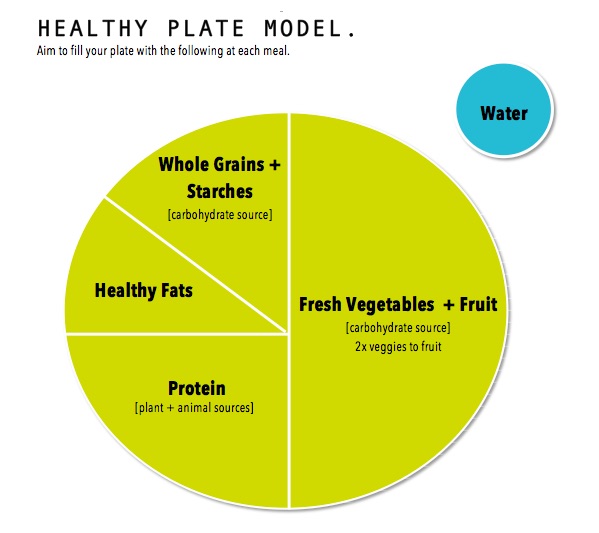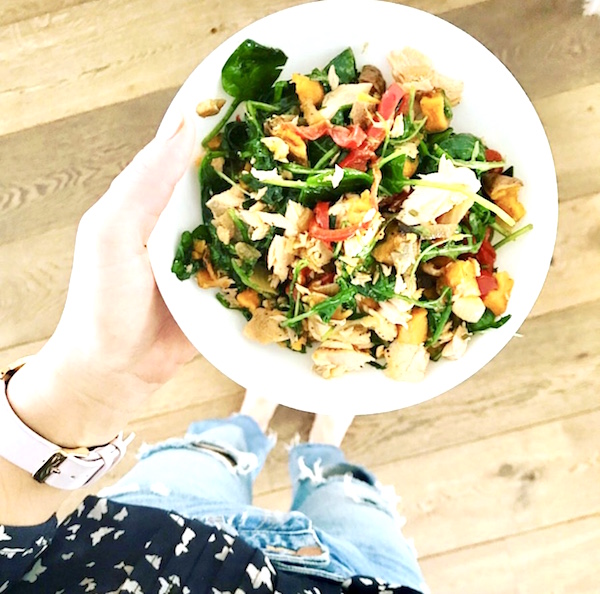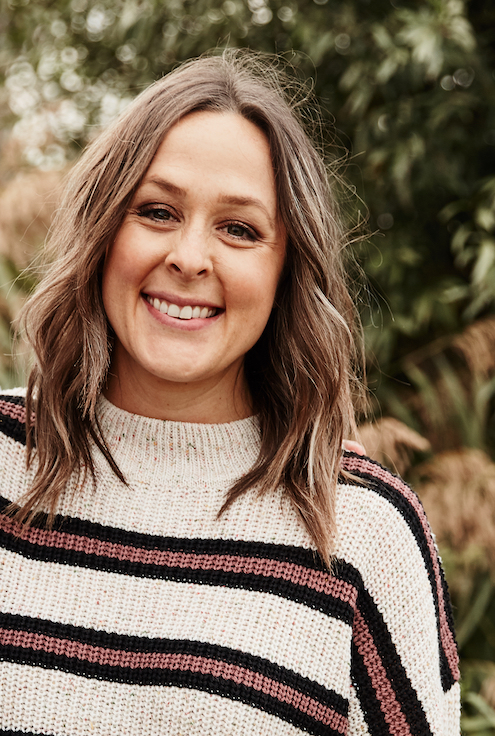Day 2 is here and I’m so glad you’re joining me again! As we move on to day 2 I want you to continue to focus on your goals from day 1 and hydrate your life. In fact, as we move through these 7 days, try and not lose sight of what you’ve already worked toward in your previous challenges. After just one week of building these healthy habits, you’ll be on your way to a happier, healthier you!
DAY 2 CHALLENGE — build a healthier, balanced plate.
Nutrition is extremely confusing. Even as a Nutritionist it makes me dizzy trying to keep up with all the nutrition fads, diets, etc. Eat this, not that. What’s the latest health trend that we must try? What food group is now bad for you?
Let me tell you something that might just change your life. Stop listening to all the hype. Stop dieting. Stop eliminating food groups [unless for a health related reason like allergies/sensitivities]. Stop counting calories. Just stop it. When we ease up on ourselves and start looking at food as it is, either real, whole food or fake, processed “food,” it starts to become a little bit less confusing. I promise.
What do I mean by building a healthier, balanced plate? It means that I want you to start looking at each meal or snack as an opportunity to nourish your body. Nourish your body with foods that truly serve you and energize you. This can be different for everyone. For example, you may think that eating raw vegetables at every meal is a duh. But let me tell you something. Some people, including myself, don’t digest raw vegetables very well. I’ve done countless cleanses that promote this way of eating and my body does not appreciate it. My digestion is off and my energy is actually lower. My body prefers cooked veggies, and so does my palate. And there’s nothing wrong with that. I still eat salads and munch on raw veggies from time to time, but you won’t see these foods as part of my regular, daily diet. And guess what. I’ve learned that about myself over time, and you’ll learn what works best for you, too. Over time.
So let’s break it down a bit without getting too technical.
There are three macronutrients that your body relies on. These include: carbohydrates, fat and protein. Including these macronutrients at each meal is a great way to start learning how to build a healthy, balanced plate. I’m not saying that you need to follow this guideline strictly. I want you to use this as an example or a general guideline. And no, not every one of my meals or your meals needs to looks like this, but I do keep this healthy plate model in the back of my mind especially when I’m planning dinners for the week.
what does a healthy plate look like?

When you look at this I just want you to visualize your plate and see where you can start to make some adjustments. Is about half of your plate filled with veggies? Do you have a protein source on your plate anywhere? What kind of fats are in your meal? Are they healthy fats? Do you have some sort of grain or starchy carbohydrate source? What is it? All of these questions that you ask yourself will eventually lead to the ability to really build healthy and nourishing meals.
And obviously you don’t need to build your plate just like this. For example, say I make tacos for dinner. My tacos may be filled with a combination of protein, fat and carbs, but it doesn’t have to be laid out like this on my plate. Again, it’s just a general guideline to help you visualize the different components of a healthy, balance meal.
here are some examples of high quality carbs that you can add to your healthy plate —
- vegetables: assorted greens, peppers, cucumber, broccoli, cauliflower, carrots, etc.
- starchy vegetables: assorted potatoes, assorted squash [butternut, acorn, etc.], peas, non-gmo corn
- whole fruit: assorted berries, banana, mango, grapes, kiwi, apples, etc.
- whole grains: brown rice, quinoa, oatmeal, buckwheat, etc.
- beans and legumes: assorted beans, lentils, etc.
here is a list of some high quality protein sources —
animal-based protein:
- pasture-raised poultry
- grass-fed beef
- pasture-raised pork
- wild-caught fish, shrimp and other seafood
vegetarian and plant-based protein:
- organic eggs
- beans
- lentils
- organic dairy [cheese, yogurt]
- raw and/or dry roasted nuts and seeds
- organic tofu or fermented soy
- quinoa
- high-quality protein powder* [*some of my favorites include: collagen peptides, Vega® protein, Garden of Life® protein]
here are some high quality healthy fat sources —
- avocado
- extra virgin olive oil
- avocado oil
- extra virgin coconut oil
- raw and/or dry roasted nuts and seeds
- nut butters
- fatty fish such as wild-caught salmon
- ghee [clarified butter]
- grass-fed butter
Notice how I talk a lot about the quality of the food you eat and not so much about quantity? I do this for a reason. This is because the quality of the food you eat truly matters most. A higher quality diet will be a healthier, more nourishing diet overall. A higher quality diet will be a more satisfying diet. A higher quality diet will energize and fuel you. A higher quality will allow you the freedom to simply eat rather than focus on calories, weights and exact amounts.
I remember back when I felt like I was never satisfied no matter how much food I was eating. And then it hit me. Like a ton of bricks. I wasn’t even eating food. I was eating processed, nonfat, sugar-free, low calorie “foods” that were so undernourishing that my body was begging for something more. For something real. Something with nutrients, with healthy fats and with calories! And let me tell you that I did not change my eating habits overnight and I don’t expect you to either. But I can promise you that if you continue to build a healthier, balanced plate [incorporating a variety of carbs, healthy fats and protein] your body will become more satisfied, more nourished and more energized. You just need to commit. Commit to a healthier lifestyle and way of eating because this way of eating is truly life changing.
What is a higher quality diet?
A higher quality diet is made up of real food. Simple as that. Foods that don’t have ingredient labels. Foods that are grown in the ground, on trees or bushes. Food from healthy, sustainably-raised animals. Foods in their simplest and most real form.
This can also mean produce grown without pesticides, animal products from animals that roam free and are not fed a diet of synthetic feed, fish that are wild and not farm-raised. I’m talking about organic, non-gmo and sustainably-raised food. Or growing your own food. For a list of the best produce to buy organic, check out the dirty dozen list. And for foods that tend to be “cleaner,” and don’t necessarily need to be bought organic, check out the clean 15 list.
As always, if you need a little extra help building a healthier, balanced plate, please reach out to me and I will guide you.
Your day 3 challenge is coming tomorrow, so don’t forget to check your inbox!





Recent Comments